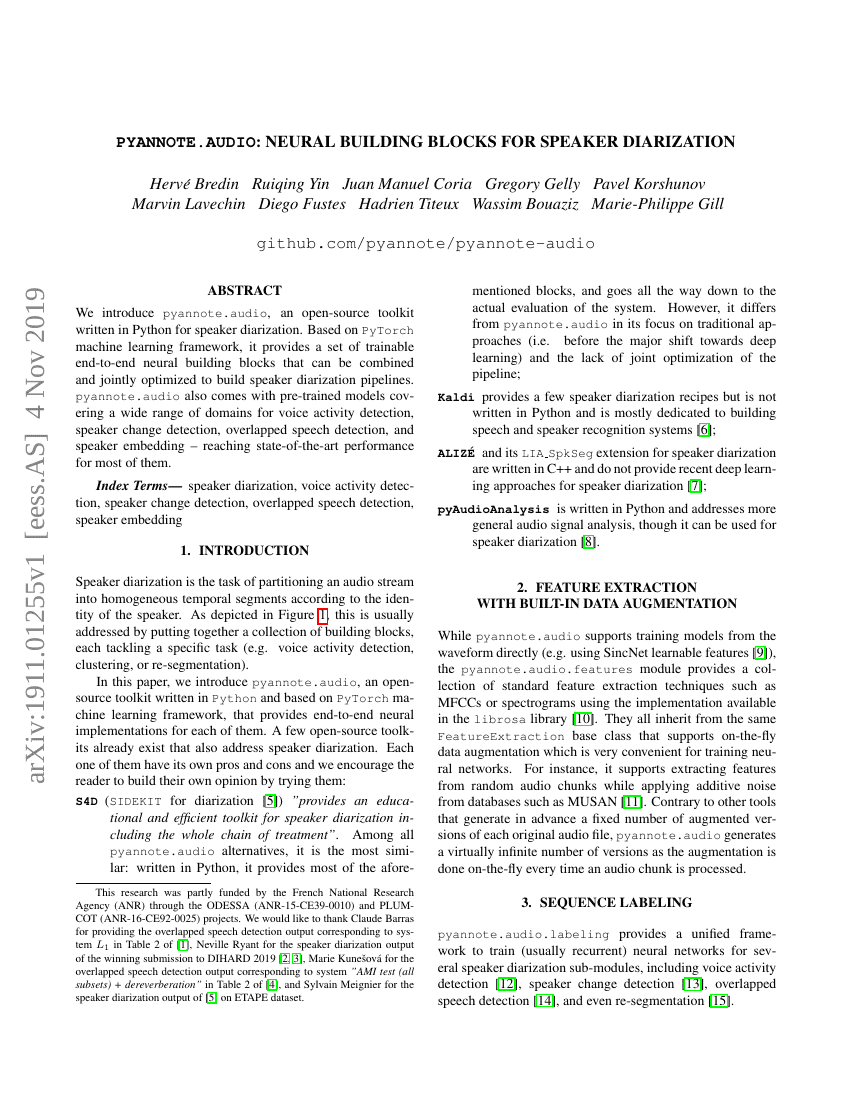Command Palette
Search for a command to run...
Hervé Bredin Ruiqing Yin Juan Manuel Coria Gregory Gelly Pavel Korshunov Marvin Lavechin Diego Fustes Hadrien Titeux Wassim Bouaziz Marie-Philippe Gill

Abstract
We introduce pyannote.audio, an open-source toolkit written in Python for speaker diarization. Based on PyTorch machine learning framework, it provides a set of trainable end-to-end neural building blocks that can be combined and jointly optimized to build speaker diarization pipelines. pyannote.audio also comes with pre-trained models covering a wide range of domains for voice activity detection, speaker change detection, overlapped speech detection, and speaker embedding -- reaching state-of-the-art performance for most of them.
Code Repositories
pyannote/pyannote-audio
Official
pytorch
muskang48/Speaker-Diarization
tf
Mentioned in GitHub
MarvinLvn/voice-type-classifier
Mentioned in GitHub
Benchmarks
| Benchmark | Methodology | Metrics |
|---|---|---|
| speaker-diarization-on-ami | pyannote (MFCC) | DER(%): 6.3 FA: 3.5 Miss: 2.7 |
| speaker-diarization-on-ami | pyannote (waveform) | DER(%): 6.0 FA: 3.6 Miss: 2.4 |
| speaker-diarization-on-dihard-1 | pyannote (MFCC) | DER(%): 10.5 FA: 6.8 Miss: 3.7 |
| speaker-diarization-on-dihard-1 | Baseline (the best result in the literature as of Oct.2019) | DER(%): 11.2 FA: 6.5 Miss: 4.7 |
| speaker-diarization-on-dihard-1 | pyannote (waveform) | DER(%): 9.9 FA: 5.7 Miss: 4.2 |
| speaker-diarization-on-etape | Baseline | DER(%): 7.7 FA: 7.5 Miss: 0.2 |
| speaker-diarization-on-etape | pyannote (MFCC) | DER(%): 5.6 FA: 5.2 Miss: 0.4 |
| speaker-diarization-on-etape | pyannote (waveform) | DER(%): 4.9 FA: 4.2 Miss: 0.7 |
Build AI with AI
From idea to launch — accelerate your AI development with free AI co-coding, out-of-the-box environment and best price of GPUs.
AI Co-coding
Ready-to-use GPUs
Best Pricing
Hyper Newsletters
Subscribe to our latest updates
We will deliver the latest updates of the week to your inbox at nine o'clock every Monday morning
Powered by MailChimp